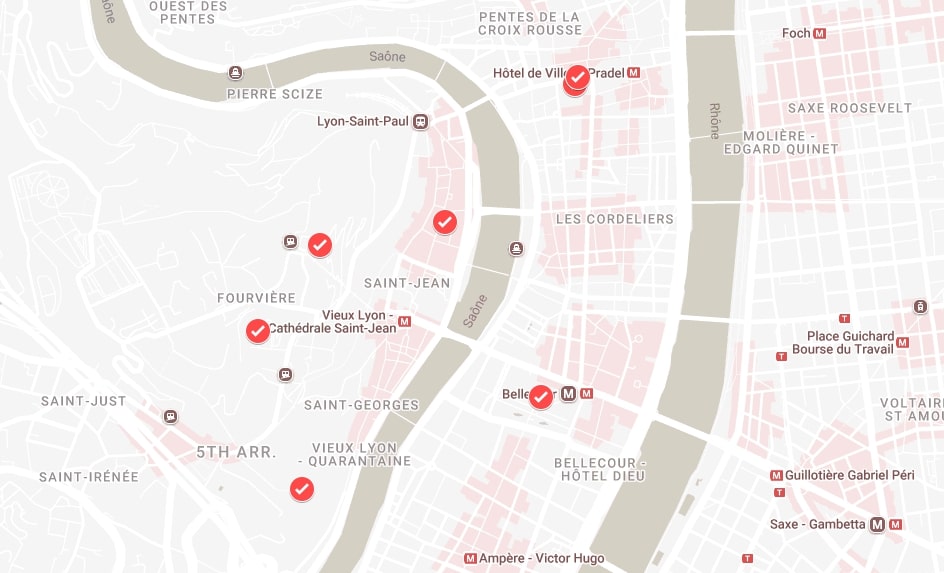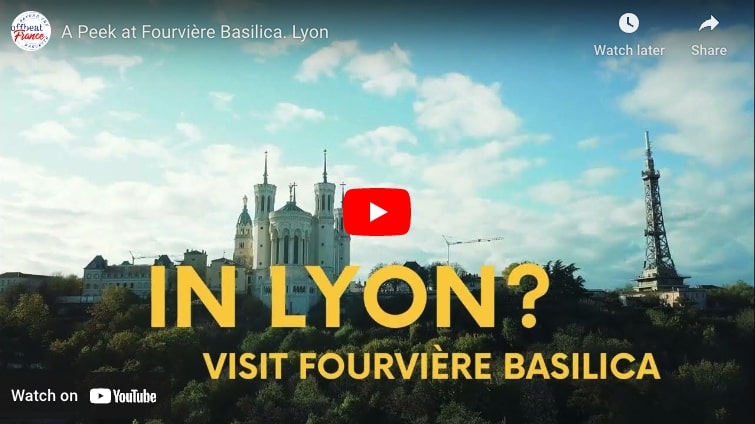Unsure about your French table manners? Click Here to download > > How to avoid these 10 food etiquette mistakes !
- Home ›
- Destinations ›
- Lyon ›
- Things to Do in Lyon
33 Irresistible Things To Do In Lyon (By A Local)
Updated 06 October 2025 by Leyla Alyanak — Parisian by birth, Lyonnaise by adoption, historian by passion
Heading to Lyon? As someone who lives nearby and has explored the city extensively, I can recommend the best things to do in Lyon, whether you're a foodie, love attractions, or want to dive into 2000 years of history.
Lyon is often bypassed as holiday-makers zip past on their way to Provence. That is such a mistake!
Please stop if you possibly can, because Provence will still be there for you, and Lyon is worth your time.
I'm lucky – I live an hour away by train, in the countryside that is part of Lyon's Auvergne-Rhône-Alpes region. So when I want the electric energy of the city, I can be in Lyon by breakfast, spend the day, and return once they start cleaning the streets.
It's a privilege I abuse often...
Planning your visit? You can skip the guesswork by using the Lyon City Card – it covers public transport and top attractions, including museums and the funicular. Or if you prefer something guided, consider this historical Old Lyon walking tour or a Beaujolais wine-tasting trip as perfect first introductions to the city.
Lyon is a city built on history, from its Roman ruins and medieval architecture to its classical neighborhoods and modern creations. You can cross more than two millennia in minutes.
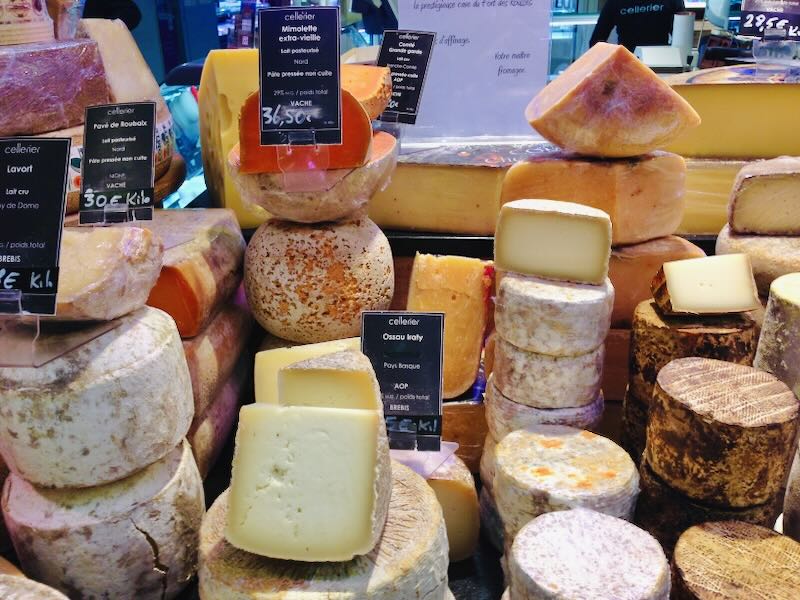 One of the best places to visit in Lyon (especially if you're here for the food) is the Halles Paul Bocuse, where culinary artisans from throughout the city show off their delicacies - like this cheese selection
One of the best places to visit in Lyon (especially if you're here for the food) is the Halles Paul Bocuse, where culinary artisans from throughout the city show off their delicacies - like this cheese selection33 irresistible things to do in Lyon
Things to do in Lyon if you’re a foodie
- 1. Sample authentic Lyonnaise cuisine at charming bouchons
- 2. Indulge in a delicate quenelle
- 3. Savor an exquisite traditional Salade Lyonnaise
- 4. Head for the pralines!
- 5. Explore Les Halles de Lyon Paul Bocuse
- 6. Awaken your inner chef with a French cooking class
- 7. Take a walking food tour of the city
- 8. Taste the wine
Things the Lyonnais like to do
- 9. Admire the horizon from the top of Fourviere
- 10. Eat at yourself silly at the Lyon Street Food Festival
- 11. Swing to the sounds of the Nuits de Fourvière
- 12. Illuminate your evening at the Fête des Lumières
- 13. Bathe in the lively atmosphere of the Lyon Bière Festival
- 14. Unwind on Les Peniches along the rivers
- 15. Indulge in retail therapy at Westfield - La Part-Dieu Mall
If you like to roam and explore
- 16. Relive the Roman Empire in old Lugdunum
- 17. Lose yourself in the medieval charm of Vieux Lyon
- 18. Feel the heart of Lyon in the dynamic Presqu’île
- 19. Delight in the trendy Croix-Rousse neighborhood
- 20. Escape to one of France's vastest parks
If you like going off the beaten path
- 21. Gaze in wonder at the astronomical clock
- 22. Discover the Musée Cinéma et Miniatures
- 23. Criss-cross Lyon’s enigmatic traboules
- 24. Step back into WWII at the Deportation and History center
- 25. Delve into the Musée des Confluences
- 26. Unearth the secrets of Lyon's Gallo-Roman Museum
- 27. Seek out Lyon's captivating murals
- 28. Gaze in awe at the majestic Fourvière Basilica
- 29. Shake your head at the metallic tower of Fourvière
Or if you just want to see the sights!
NOTE: Pages on this site may contain affiliate links, which support this site. See full Privacy Policy here.
If you're visiting Lyon for the first time, this Lyon travel guide will show you around.
And if you're already addicted to the city, I just might be able to uncover a thing or two you haven't discovered yet (like this unusual pedicab tour or the cathedral's hidden astronomical clock).
Map of Lyon attractions
Because this city has so much to offer, I've divided it into themes.
What follows are the top attractions and activities in Lyon across every mood.
Things to do in Lyon if you're a foodie
What is the city of Lyon famous for?
Food, of course!
That's why so many people call Lyon France's gastronomic capital.
Curnonsky − France's most famous 20th-century gastronomy writer − said so, and the famed “prince of gastronomes” should know.
Even some Parisians say so, and who’s to argue with them?
It started with the first “mothers”, women whose welcoming establishments (known as “bouchons”) fed the city’s silk workers. Equally famous is the late chef Paul Bocuse, native son, revolutionary proponent of Nouvelle Cuisine, voted chef of the century, and dubbed the Pope of French Cuisine.
Just in case you wanted to confirm Lyon's food credentials...
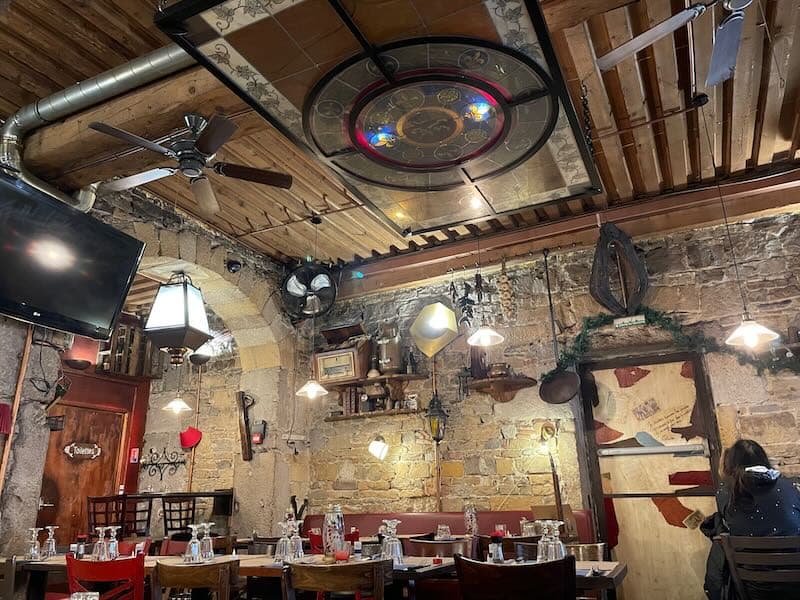 While some bouchons are older and quirky, like this one, others are sleek and modern. It's not so much the decor but what's on the plate
While some bouchons are older and quirky, like this one, others are sleek and modern. It's not so much the decor but what's on the plate1. Sample authentic Lyonnaise cuisine in a bouchon
A bouchon, literally, means a cork.
Not in Lyon though. Here, a bouchon is a traditional eatery, serving typical Lyonnaise food.
These small establishments date back to the 19th century and were run by (mostly) women to feed the city’s silk workers.
No visit to Lyon would be complete without at least one bouchon meal.
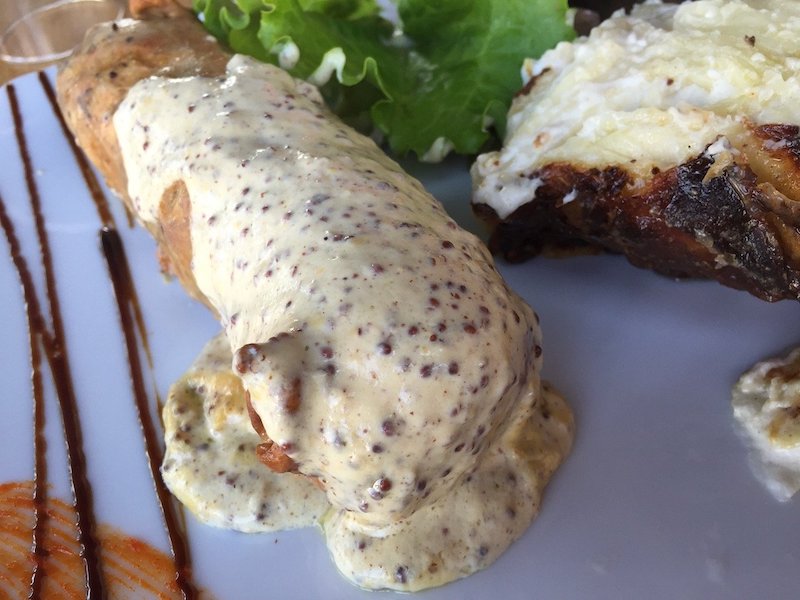 An Andouillette, tripe sausage with a mustard sauce (far tastier than it sounds!)
An Andouillette, tripe sausage with a mustard sauce (far tastier than it sounds!)Lyon's hearty, traditional cuisine is particularly rich, involves meat (usually pork), and often includes some sort of offal, possibly tripe. And no, you don't have to try tripe if you don't like it.
HOW TO MAKE SURE YOU'RE EATING IN A REAL BOUCHON
Not every restaurant calling itself a bouchon actually is one. To make sure you’re getting the real experience, here’s what to look for:
- Check for the “Les Bouchons Lyonnais” label (see logo below). While not all bouchons belong to it, the logo guarantees the restaurant serves traditional dishes, uses local ingredients, and maintains Lyon’s culinary heritage.
- Look at the menu. Authentic bouchons feature classics like quenelle de brochet, andouillette, tablier de sapeur, salade lyonnaise, and cervelle de canut. If you spot words like pizza or burgers on the menu, keep walking.
- Test the atmosphere. True bouchons are small, noisy, friendly and crowded, often with checkered tablecloths, wood paneling, and a convivial feel.
-
Ask shopkeepers or hotel staff for their favorites – they're bound to have one!

If you’re short on time, you can also join a guided bouchon and food tour, which takes you to a mix of certified and hidden favorites.
You're vegetarian? Steer clear of bouchons. Even the salads have meat...
There is at least one vegan food tour in Lyon, in the silk-weaving district, and Lyon's restaurants are increasingly offering vegetarian options, but the list of dishes is short.
2. Indulge in a delicate quenelle
To sample cuisine Lyonnaise, start with a “quenelle de brochet”. You’ll find it on most menus, and it’s a likable dish, not as offputting as offal.
A quenelle is basically a shape rather than a dish, rather oblong with rounded ends, a bit like a rugby ball. It is usually made of pike (brochet) and comes with a crayfish sauce, although there are chicken versions. It’s relatively light and flavorful, and a perfect introduction to local cuisine.
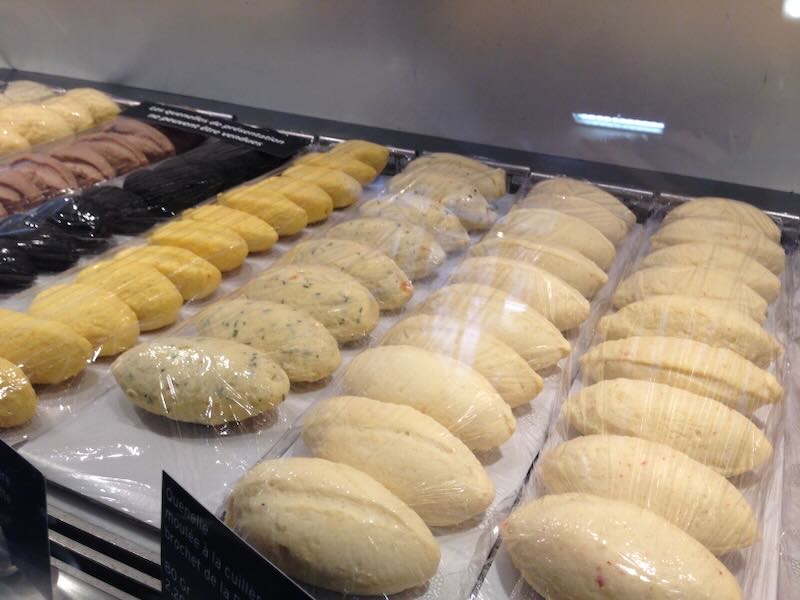 And these are what quenelles look like
And these are what quenelles look like3. Savor a traditional Salade Lyonnaise
This is another likeable dish and easily found in bouchons and in regular restaurants – and typically local.
Have it as a starter or for lunch.
It is made of lettuce (frisée, if possible), bacon chunks, fried croutons and a poached egg, all slathered with vinaigrette.
If you take your dressing on the side, be aware that this is not customary in France and might be difficult to convey.
Try showing them this sentence: “La vinaigrette sur le côté, s’il vous plaît.” But no promises.
ARE YOU LOOKING FOR CULINARY BOOKS?
📖 Dirt: Adventures in Lyon as a Chef in Training
A fun read, a family memoir with plenty of heartwarming Lyon food experiences
📖 Simca's Cuisine: One Hundred Classic French Recipes For Every Occasion
An absolute classic with authentic French food recipes for every occasion
📖 Mastering the Art of French Cooking (2 Volume Set)
The cornerstone of every kitchen that styles itself as French
4. Head for the pralines!
A fitting end to your bouchon meal would be something with pralines, much loved in Lyon. Our pralines, by the way, are probably different from yours: here, a praline is an almond dipped in pink caramelized sugar.
Try a praline tart, made of crushed pralines, delicious but a little hard on the teeth.
This is a relatively new dessert, invented a few decades ago to round off a bouchon meal. The pralines already existed – the only thing missing was the pie shell.
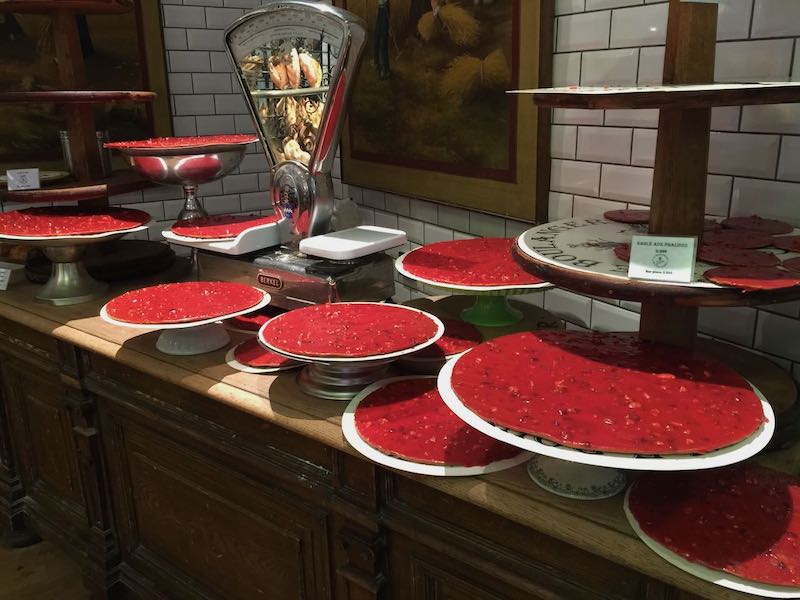 Colorful praline tarts - sweet and addictive
Colorful praline tarts - sweet and addictive5. Explore Les Halles de Lyon Paul Bocuse
The Halles Paul Bocuse is the summit of foodiness in Lyon, a luxury indoor market with stalls and shops representing Lyon's top suppliers and artisans.
The moment you enter this exclusive, delightful, amazing Lyon food market, you'll be hooked.
The decor is banal at best, dark-ish at worst, but everything you sample will be exquisite perfection (with a price to match), from splendid escargots to seafood to all the makings for your French picnic.
I thoroughly enjoyed taking a private tour of Les Halles, which pointed me in the right direction for my first visit and showed me who was who. After that, I returned on my own… again and again.
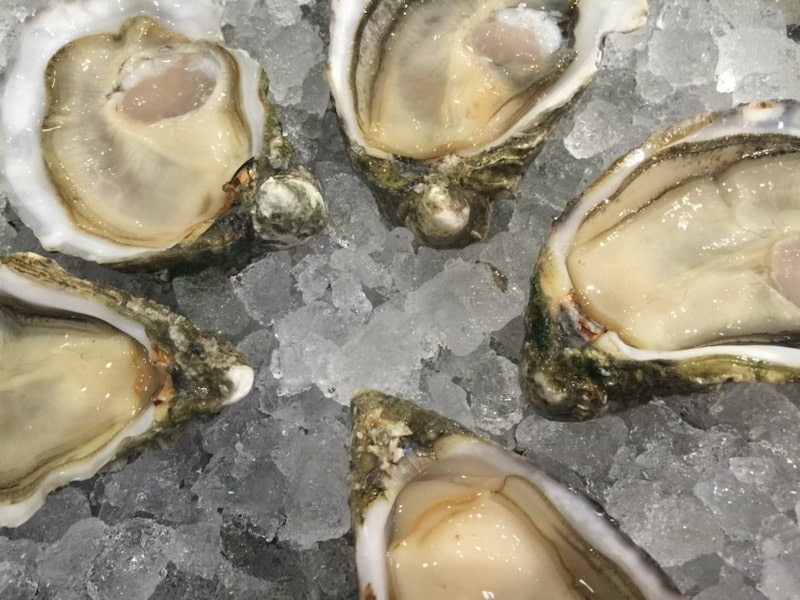 Oysters fresh from the coast that morning at Les Halles Paul Bocuse
Oysters fresh from the coast that morning at Les Halles Paul BocuseTo maximize your time here, here's a list of all the shops and eateries at Les Halles de Lyon, and here is the floor plan so you can find your way around.
6. Awaken your inner chef with a French cooking class
Surrounded by so much food, why not learn to make your own?
You could spend the afternoon with a pastry chef or learn to pair wines with Lyonnaise specialties.
Or learn to make croissants or tarte tatin!
If you're going to dip your toes into French cooking, Lyon is a great place to start.
7. Take a walking food tour of the city
You can taste Lyon's foods on your own, but if you want to sample as much as possible and don't have much time, take a food tour in Old Lyon to sample some of the city’s specialties.
8. Taste the wine
It can’t have escaped you that Lyon is surrounded by prime wine country – Beaujolais, Chablis, Côtes du Rhône and more.
Why not spend a few hours tasting some of these world-renowned wines?
Here are some suggestions for city wine escapes, from a few hours to a full day:
BOOK A WINE-TASTING TOUR AROUND LYON
🍷 Half-Day Beaujolais Wine-Tasting Tour
If you’re keen on wines, this oenological workshop compares the best wines you’ll be tasting in Lyon’s restaurants, so you'll arrive prepared.
If you want to do what the Lyonnais do
9. Admire the horizon from the top of Fourviere
Summer evenings are crowded behind the Fourvière Basilica… this is when groups of local friends exchange the heat of the city below for a cool breeze and an expansive view.
They might bring a picnic, or grab something from the coffee shop (it closes a bit early for summer, at 8pm).
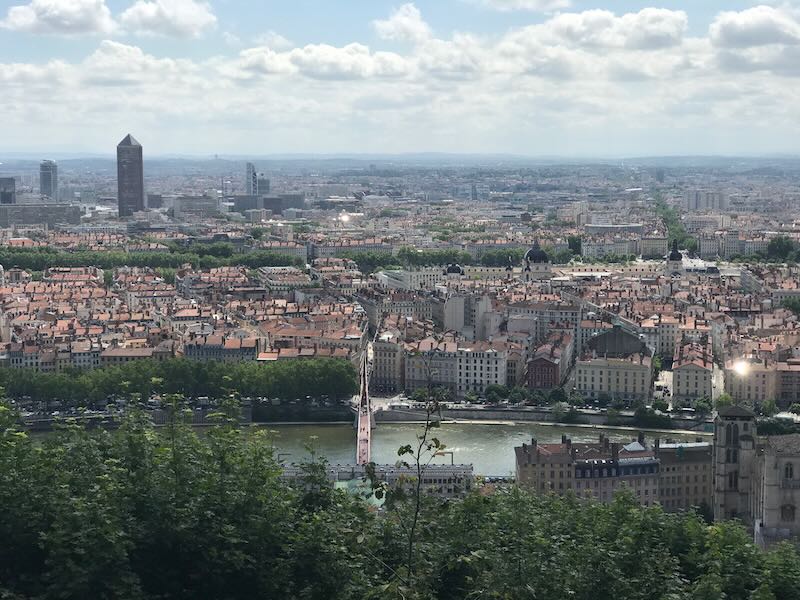 A must-see in Lyon is the view from Fourviere. You can make half a day of it... Start with the Roman ruins of Lugdunum and the Gallo-Roman museum, then visit the basilica, and stick around for this stunning view (better in person than in my pictures!)
A must-see in Lyon is the view from Fourviere. You can make half a day of it... Start with the Roman ruins of Lugdunum and the Gallo-Roman museum, then visit the basilica, and stick around for this stunning view (better in person than in my pictures!)10. Eat at yourself silly at the Lyon Street Food Festival
People who live in Lyon do love a good festival… and this one is becoming a favorite.
Each June, long lines of foodies await the opening of the gates of what has become an eating extravaganza of note, with the participation of some of the world's most starred chefs preparing... street food (but not only).
Here's my account of the festival, since I go every year. If you're visiting Lyon in June, you'll be in for a treat.
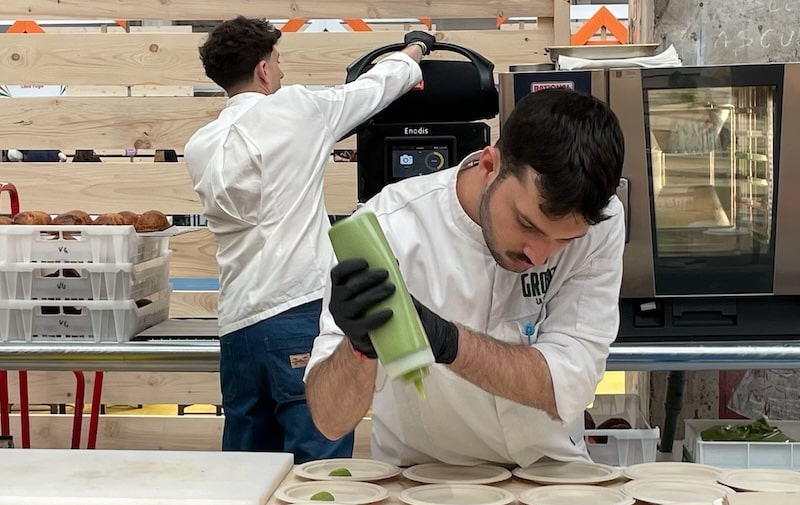
11. Swing to the sounds of the Nuits de Fourvière
Around the same time as the Street Food Festival, the city turns into a musical event with the Nuits de Fourvière, named after the hill on which it takes place.
This is quite a magical event: concerts are staged against a backdrop of Antiquity, right inside the Roman amphitheater that was used for performances as long as 2000 years ago.
Big names in French music can be expected to perform, and tickets sell out quickly.
12. Illuminate your winter evenings at the Fête des Lumières
Visiting Lyon in December? There's one event to aim for: the annual winter light festival.
I do love a good light show, and this one is spectacular, with different artists showing off their stunning light creations each year.
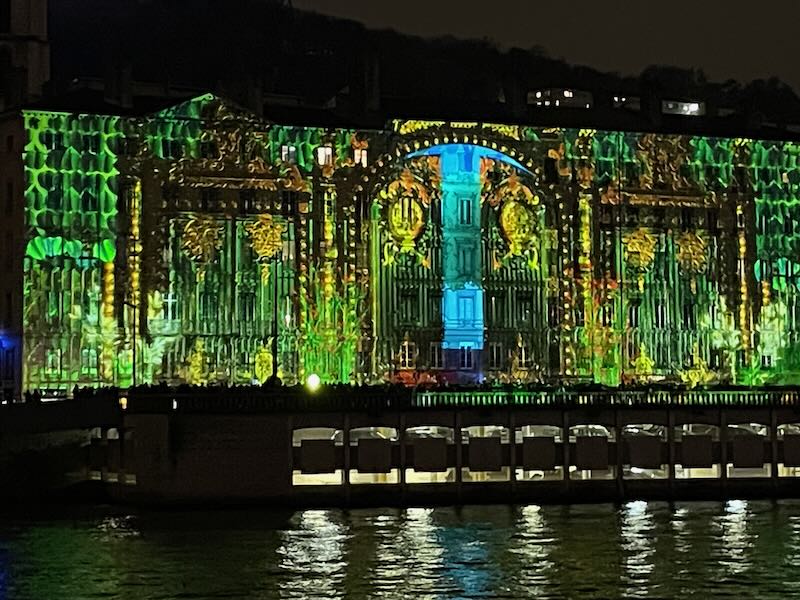 Lights dance across the buildings of Lyon during the Fête des Lumières each December
Lights dance across the buildings of Lyon during the Fête des Lumières each December13. Bathe in the lively atmosphere of the Lyon Bière Festival
Did I mention Lyon was a festival city?
It may be surrounded by wine but Lyon also happens to be a brewer of note, a tradition developed during the 18th century by immigrants from Germany.
Beer consumption rose and fell in the following years but interest in brewing is now growing and each April, you can sample local craft brews (and imported ones) at the Lyon beer festival.
14. Unwind on les Péniches along the riverside
Lyon has not one, but two rivers flowing through it, the Saône and the Rhône, so there is plenty of riverside action.
A favorite of locals is a summer evening outing to the houseboats, or “péniches”, moored along the water – for example along the Quais Victor Augagneur, des Etroits, Perrache, Rimbaud…
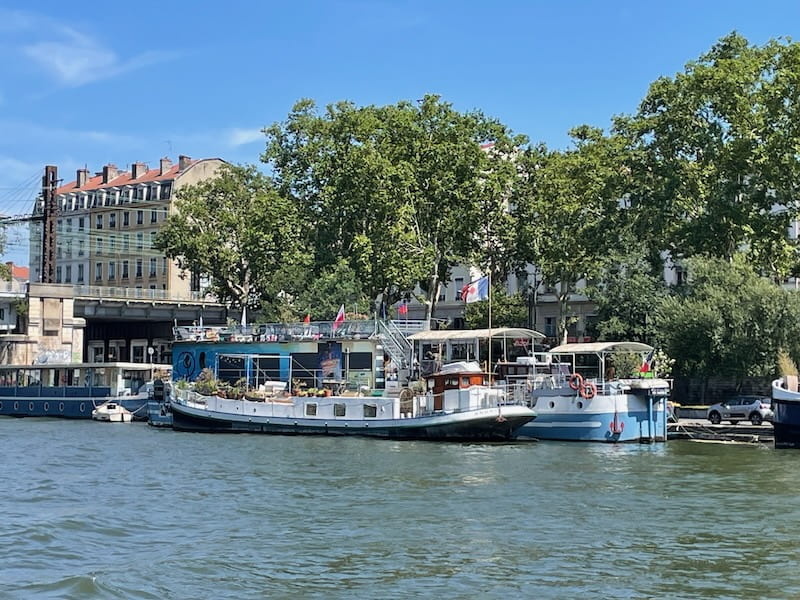 Houseboats along Lyon's rivers - many of these are bars and restaurants in the evening
Houseboats along Lyon's rivers - many of these are bars and restaurants in the evening15. Indulge in retail therapy at Westfield − La Part-Dieu Mall
While French shopping habits still tend towards small neighborhood shops, malls are growing in importance, but none as much as this central Lyon behemoth, whose recent expansion has made it the largest downtown mall in Europe.
On weekends, it’s elbow room only but its multitude of shops, restaurants and entertainment venues mean there’s always something to do.
You can’t miss it – it’s right across the street from the Part-Dieu train station.
If you like to roam and explore
16. Relive the Roman Empire in old Lugdunum
I have a weakness for Roman ruins and the ones in Lyon are particularly spectacular.
Lugdunum, as Lyon was once called, was important to the Roman Empire during the first century BCE as the capital of the province of Gaul (which eventually grew into France).
The massive amphitheater is spectacular, along with the smaller odeon beside it. It's quite a feeling to clamber onto stones which, millennia ago, seated august Romans waiting for their entertainment to begin.
To get there, take the Funicular up from the Old town towards St Just and get off at Minimes. When you exit, turn right, walk a little and the ruins are on your left. Or, if you're up at Fourvière, walk downhill for five minutes (following the signs).
Exploring these ancient Lyon attractions gives you a sense of how the city evolved.
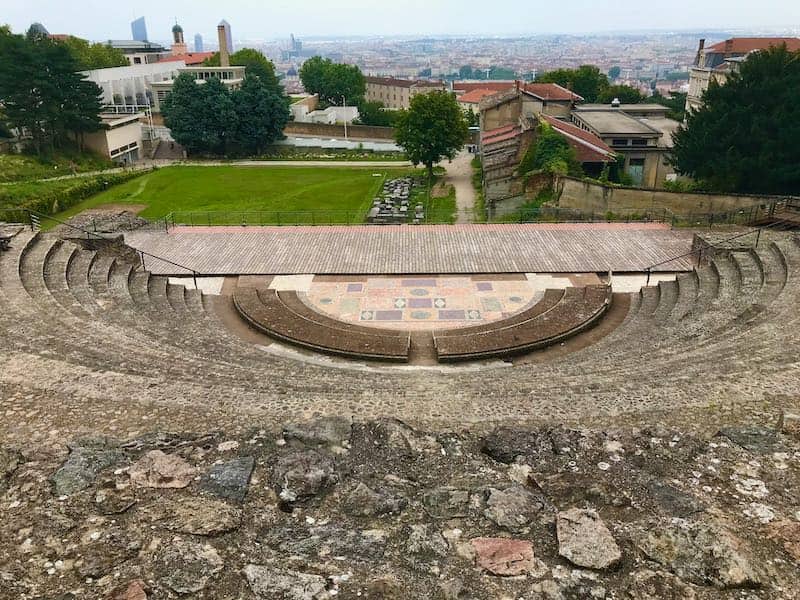 The Roman amphitheater at Lugdunum, beautifully preserved and still used for summer concerts
The Roman amphitheater at Lugdunum, beautifully preserved and still used for summer concerts17. Lose yourself in the cobblestoned charm of Vieux Lyon
During the 19th century, Old Lyon was a dirty den of thieves, so insalubrious it was almost destroyed until local associations lobbied successfully for its preservation – and it was eventually included as a UNESCO World Heritage Site.
Old Lyon stretches inward from the west bank of the Saône to the lower reaches of Fourvière Hill.
With cobblestones galore, the area is stuffed with eateries and shops (and excellent ice cream parlors), particularly welcome on a hot summer day. One of the area’s main attractions are the local “traboules”, or not-so-secret tunnels that lead from one street to the next through a building.
In the evening, find a breezy terrace and enjoy some of Lyon’s culinary specialties. Even better if you can get a seat in an authentic bouchon!
And for something really different, why not an escape game that takes place in this centuries-old quarter?
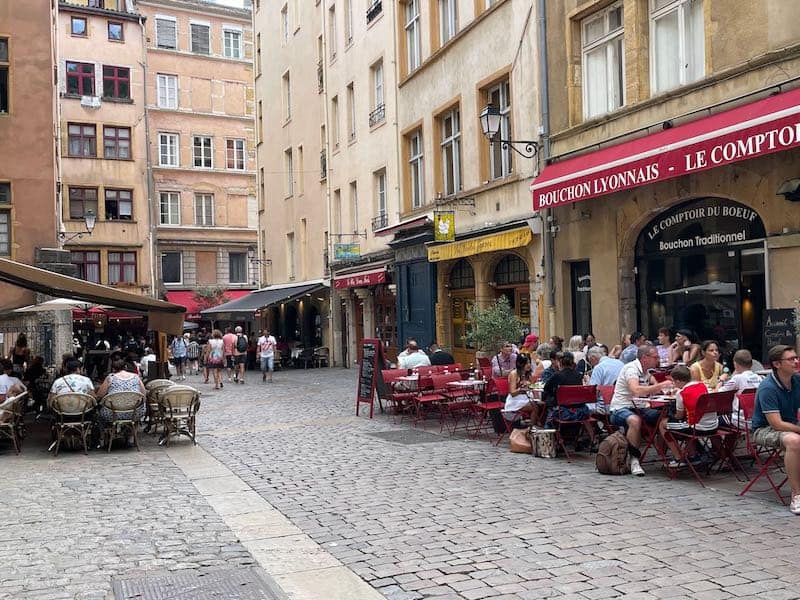 A typical scene in Lyon's Old Town
A typical scene in Lyon's Old Town18. Feel the heart of Lyon in the dynamic Presqu’île
One of the (many) nice things about Lyon is that it is divided up into easily distinguishable neighborhoods, with the Presqu'île (which means peninsula) leading the way for shopping and classical architecture. It is particularly attractive at night, when many of the classic buildings, such as the City Hall and the Courthouse, are illuminated.
This is also where you'll find the world-famous Opéra de Lyon, an unusual building: to enlarge and renovate the old structure, a semi-circular dome was built on top of it, marrying classical and modern architecture. It took me time to appreciate it but now I love it.
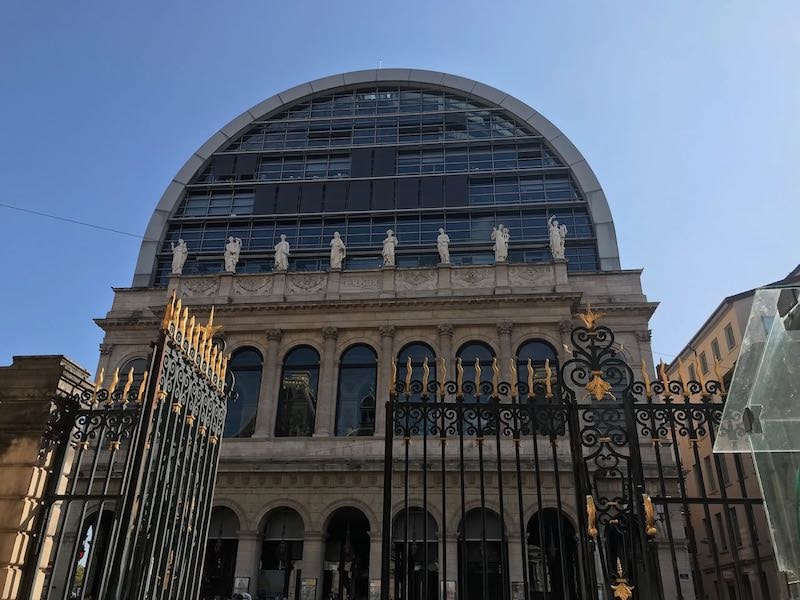 Lyon's Opera House: the 19th century building ended just before the row of muses, added latet, but the dome was added only a few decades ago
Lyon's Opera House: the 19th century building ended just before the row of muses, added latet, but the dome was added only a few decades agoThis neighborhood is also home to Place Bellecour, one of Europe's largest (and the site of the Lyon tourist office), and the Place des Terreaux, with its famous Bartholdi fountain.
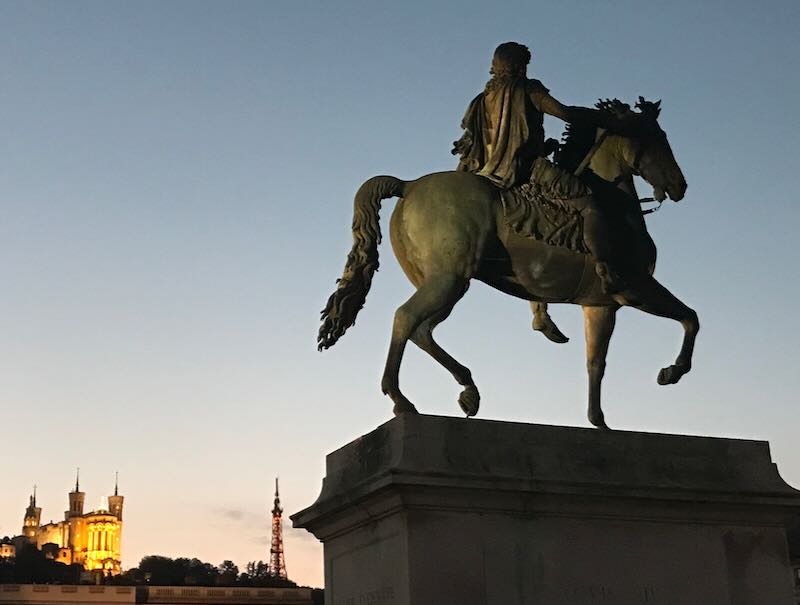 The statue of Louis XIV on Place Bellecour, and on the hill beyond, Fourvière Basilica. And no, that's not the Eiffel Tower, but a metallic tower that now serves as a communication hub.
The statue of Louis XIV on Place Bellecour, and on the hill beyond, Fourvière Basilica. And no, that's not the Eiffel Tower, but a metallic tower that now serves as a communication hub.19. Delight in the trendy Croix Rousse neighborhood
You've probably heard it often enough: Lyon is the Capital of Silk. But what does that mean, exactly?
While Lyon's prosperity is now driven by newer industries, it was once highly dependent on silk. François I (Francis I) gave Lyon the silk monopoly, and Louis XIV made French silk indispensable by decreeing the cloth at his court must be made in France.
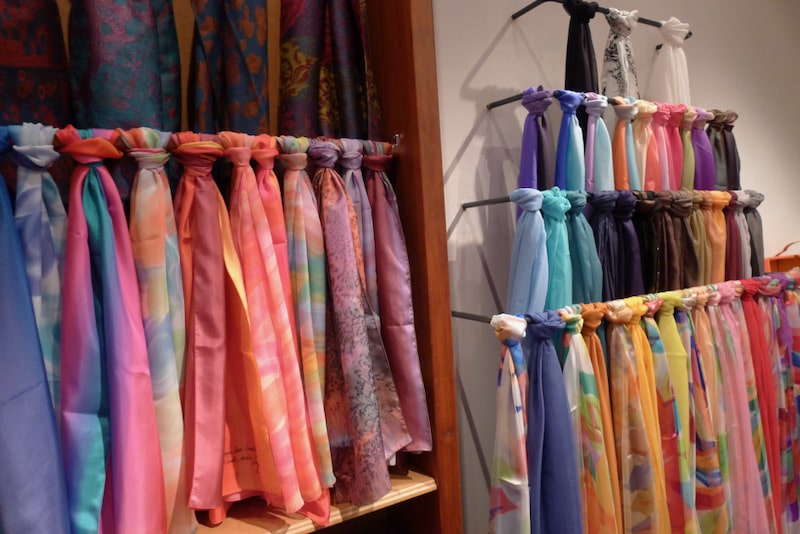 Silk shops dot the streets of Croix-Rousse Hill
Silk shops dot the streets of Croix-Rousse HillSilk temporarily fell on hard times during the French Revolution, only to be rescued by Napoleon. It went from strength to strength until the arrival of synthetic cloth in the 1880s drove the industry away.
But all is not said and done.
Young designers are forging ahead with new uses for silk and putting their hand to the restoration of historical textiles, while houses of haute couture still order their silk from Lyon. Up on Croix-Rousse Hill, which the silk trade called home, silk still thrives.
To follow in the footsteps of Lyon’s silk workers, take this silk tour through former workshops and historic silk passageways and learn about the trade that once put Lyon at the heart of European commerce.
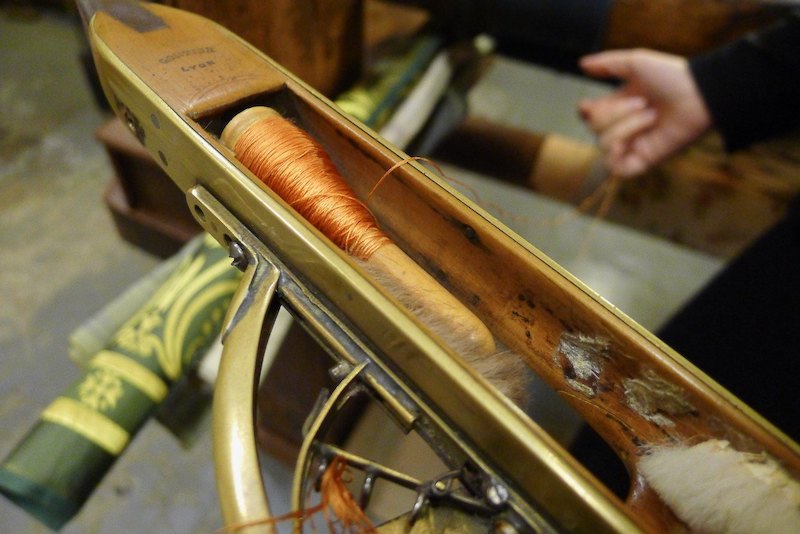 One of the many silk exhibits still on display in Croix-Rousse
One of the many silk exhibits still on display in Croix-Rousse20. Escape to one of France's vastest parks
A contemporary of New York’s Central Park, the Tête d’Or (Golden Head) is one of France’s largest urban parks (the Lyon tourist office says it is actually the largest).
There’s something for everyone here: corners where you can relax and play games, a zoo with 64 animal species, a botanical garden, and a rose garden. You’ll see plenty of families having a picnic, students taking a nap on the grass, or couples getting married!
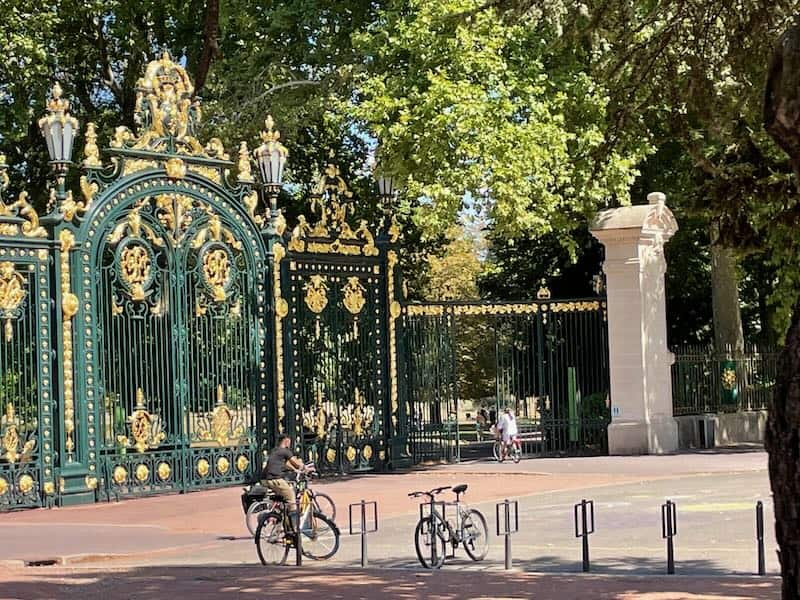 Stunning entrance gates of the Parc de la Tête d'Or in Lyon
Stunning entrance gates of the Parc de la Tête d'Or in LyonPLANNING ON VISITING MUSEUMS?
If so, and especially if you're planning to use public transportation, consider getting a Lyon City Card for one or several days.
If you like what’s off-the-beaten-path
Lyon is full of the unusual, with places that make you look twice and stories and legends that make you shake your head in surprise and wonder.
21. Gaze in wonder at the astronomical clock
If you’re melting in the summer and happen to be visiting the Old Town, step into the 12th-century Cathédrale Saint-Jean, whose largely sober interior is set off by a whimsical astronomical clock which used to strike the hour several times a day (it was vandalized in 2013 and as of this writing is under repair).
When you enter the church, head towards the altar on the left side. The clock is on your left just a bit before the altar. It may or may not be covered in scaffolding.
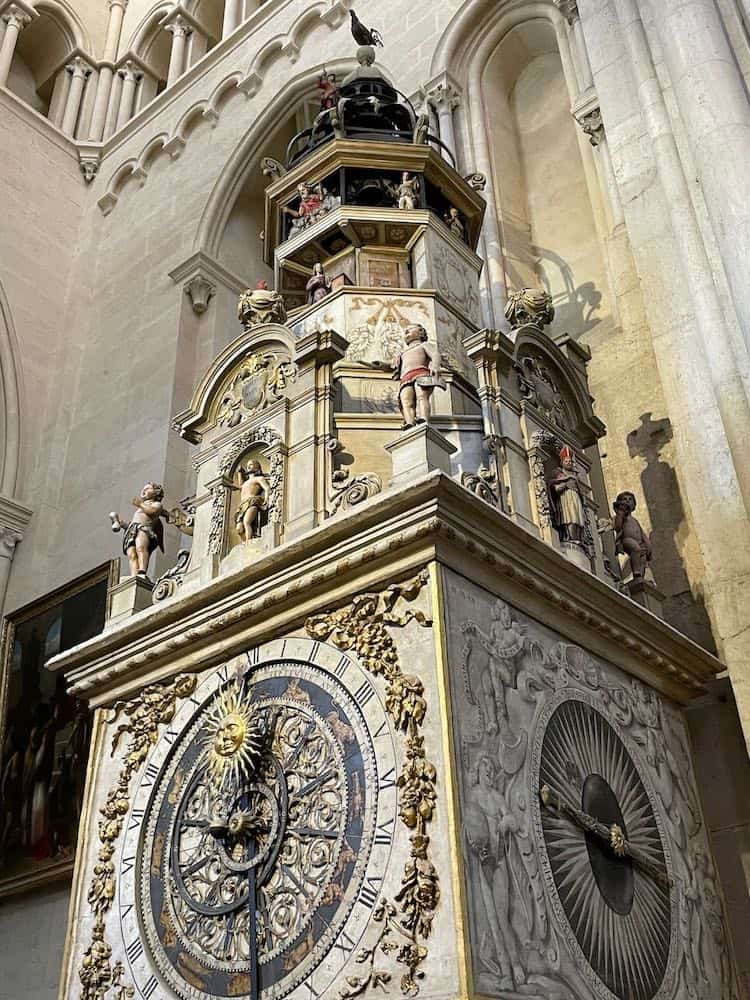 The delightful astronomical clock in St Jean cathedral - one of the oldest and most complex clocks in Europe
The delightful astronomical clock in St Jean cathedral - one of the oldest and most complex clocks in Europe22. Discover the Musée Cinéma et Miniatures
The fascinating Movies and Miniatures Museum is miniaturist Dan Ohlman’s passion project – and is in fact two museums in one.
The cinema section has more than 500 costumes and props from the world’s major film studios: Mary Poppins’ umbrella, anyone? How about the mask from “Mask”?
What really caught my eye, though, is the second museum and its exhibition of more than 120 hand-made miniatures. If you’ve ever eaten at Maxim’s in Paris, you’ll find it reproduced here, on a tiny scale, along with plenty of interiors from the famous to the merely familiar.
It is absolutely one of the most fun Lyon things to do, especially with kids but equally intriguing for adults.
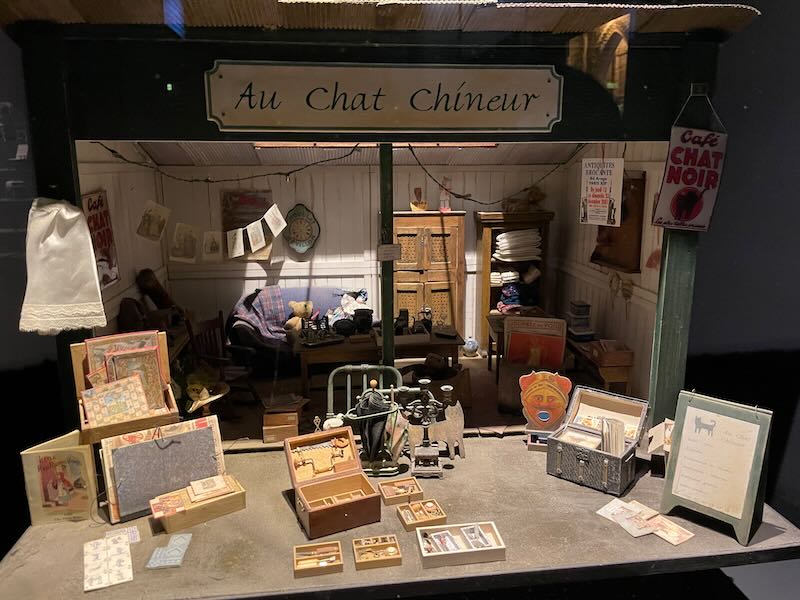 One of the 120 delightful miniatures on display - this is an ancient antique shop
One of the 120 delightful miniatures on display - this is an ancient antique shop23. Criss-cross Lyon’s enigmatic traboules
One of the most popular things to do in Lyon Old Town (and also in Croix-Rousse) is to explore the traboules, or secret passageways.
They lead from one street to another, usually through a patio or hallway.
They were probably built to make it easier to carry water uphill from the riverside. Later, they would be used by silk traders to carry bolts of cloth from the workshops down to waiting ships below, avoiding rain in the process.
More recently, Resistance fighters used them to hide from the Gestapo.
These days, few – fewer than 50 – of the original 500 remain open to the public, but a private walking tour will take you to some of the iconic ones.
The Lyonnais themselves use these all the time to get from one street to another. Most are surrounded by dwellings, so avoid making noise. This way, residents won't complain and the few remaining traboules will stay open!
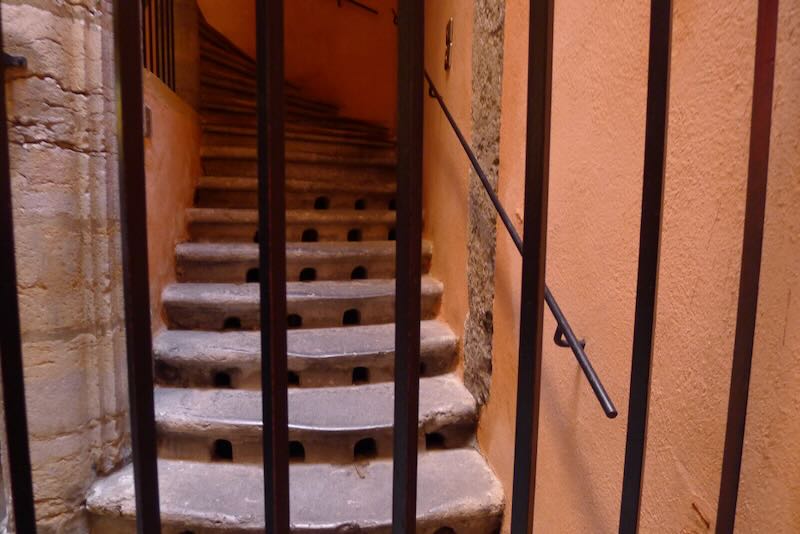 Some traboules are open to the public but others, like this one, are for residents only
Some traboules are open to the public but others, like this one, are for residents only24. Step back into WWII at the Deportation and History Center
For World War II history buffs, the Deportation and Resistance History Center retraces the role of Lyon during the Second World War. It also happens to be located right inside the former Gestapo headquarters. The juxtaposition of the stories of Holocaust survivors and the stairs used by Gestapo officials may leave you somewhat uneasy.
If this era fascinates you, take advantage of a day walking tour that highlights Lyon as the capital of the Résistance.
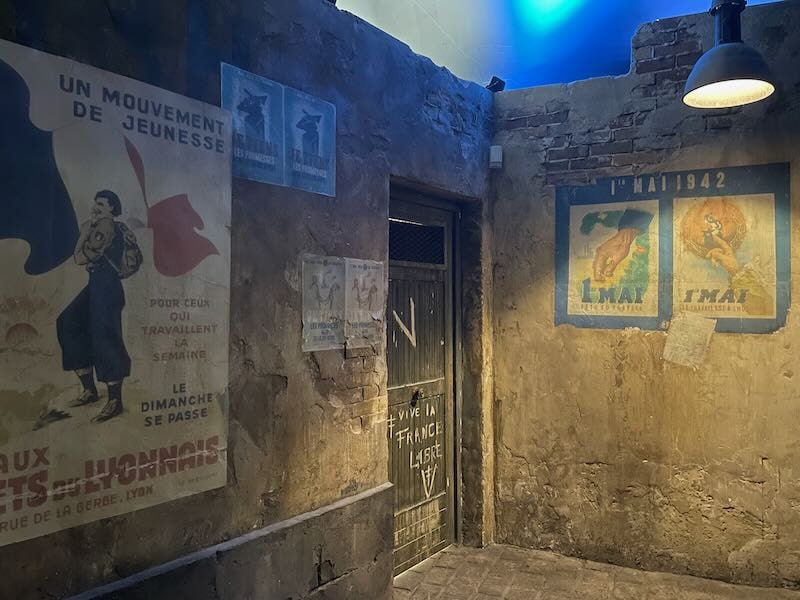 A few rooms from World War II have been replicated in the Resistance Center and museum
A few rooms from World War II have been replicated in the Resistance Center and museum25. Explore the Musée des Confluences
The Musée des Confluences is an architectural flight of fancy amid Lyon’s mostly classical and medieval architecture. A bit like a futuristic ship, this large-scale anthropological museum sits at the confluence of the Rhône and Saône rivers. This lovely one-hour cruise will unveil it from the water, but wherever you see it from, it almost defies description.
In the museum's own words, it "tells the story of mankind and the history of life." Just go. And climb to the rooftop terrace for a view.
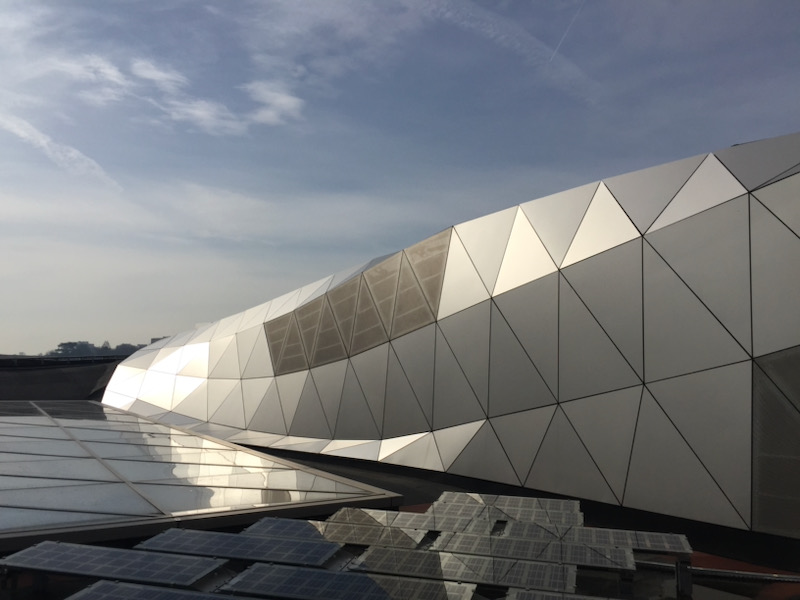 The extraordinary sail-shaped exterior of the Musée des Confluences
The extraordinary sail-shaped exterior of the Musée des Confluences26. Unearth the secrets of Lyon's Gallo-Roman Museum
For even greater insight into Lugdunum's former inhabitants, immerse yourself in the Gallo-Roman Museum, right next to the amphitheater.
The museum is built into the hill above the amphitheater so it looks perfectly natural.
Of particular note are some near-perfect mosaics that once adorned the floors and walls of wealthy citizens' homes.
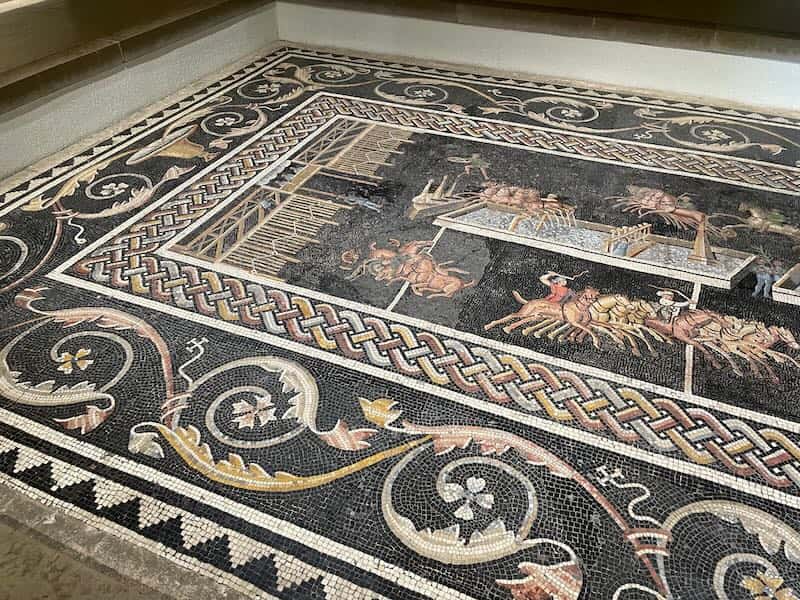 One of the several breathtaking mosaics on display at the Gallo-Roman Museum of Lyon-Fourvière
One of the several breathtaking mosaics on display at the Gallo-Roman Museum of Lyon-Fourvière27. Discover Lyon's captivating murals
For many visitors, possibly the best things to see in Lyon are its 150 outdoor murals, extraordinary works of art that mostly unfurl above eye level.
You'll probably stumble upon a few without looking for them, like the Fresque des Lyonnais, and look for others without finding them.
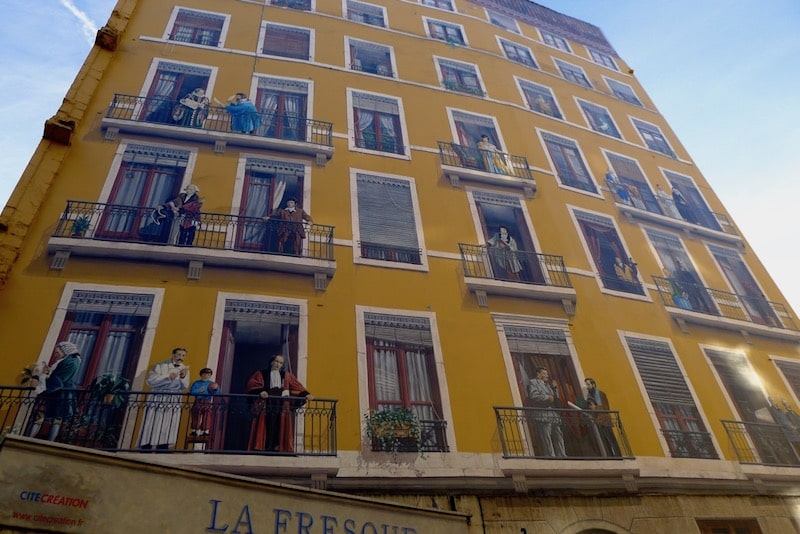 La Fresque des Lyonnais, one of the most famous frescoes
La Fresque des Lyonnais, one of the most famous frescoesSome depict famous Lyonnais, others show scenes from daily life, and yet others look like they've come straight from a science fiction movie.
Have a look at some of the best murals here.
28. Gaze in awe at the majestic Fourvière Basilica
After having roamed around the hill a few times, consider entering the crown jewel itself.
Its blinding white façade is a relatively new addition (1872) to the Lyon skyline. Its four towers stand for the cardinal virtues of Justice, Temperance, Fortitude and Prudence.
The building is an architectural oddity, as though its designer couldn't decide among Byzantine, Gothic and Romanesque styles. The result is eclectic but charming, with plenty to look at. Perhaps charming isn't the right word, but neither is serene. Go see it: it just works!
The basilica is made of two superimposed churches. The first, or Upper Church, is spacious and intensively decorated, with plenty of mosaics, columns, stained glass windows and marble, a true feast for the eyes.
A monumental staircase leads below to the lower church, erroneously referred to as the crypt (if it has windows, it isn't a crypt).
For a view even more striking than the one behind the basilica, take its Rooftop Tour but beware of the 300+ steps you'll have to climb to get there. If you're up to it, it's worth it. The tour is in French, but the view is universal. (They can organize tours in English if you have a larger group).
29. Metallic tower of Fourvière
Are your eyes deceiving you, or is this a miniature Eiffel Tower?
No, you’re not dreaming.
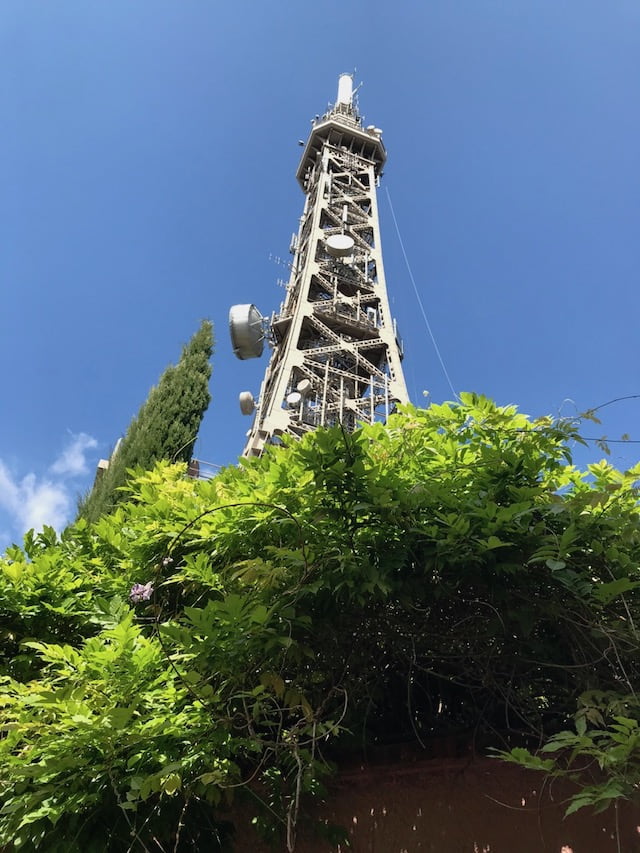 It does look a bit like the Eiffel Tower, doesn't it?
It does look a bit like the Eiffel Tower, doesn't it?It was built to house a restaurant during the 1894 Lyon World Fair but has been converted into a telecommunications tower. It sits right next to the Fourvière Basilica, so you can’t miss it.
Who knows, maybe Eiffel had a hand in its building…
Or for some Lyon sightseeing...
30. Ride the Funicular to Fourvière Hill
One of the best spots for sightseeing in Lyon is to see the city from above, and as we’re already said, the best viewpoint is on Fourvière Hill, behind the basilica.
But riding the funicular is part of the fun. The steep little railway that climbs up from the Old Town is known locally as La Ficelle, the string. Just buy your ticket at the entrance or use your Lyon City Card.
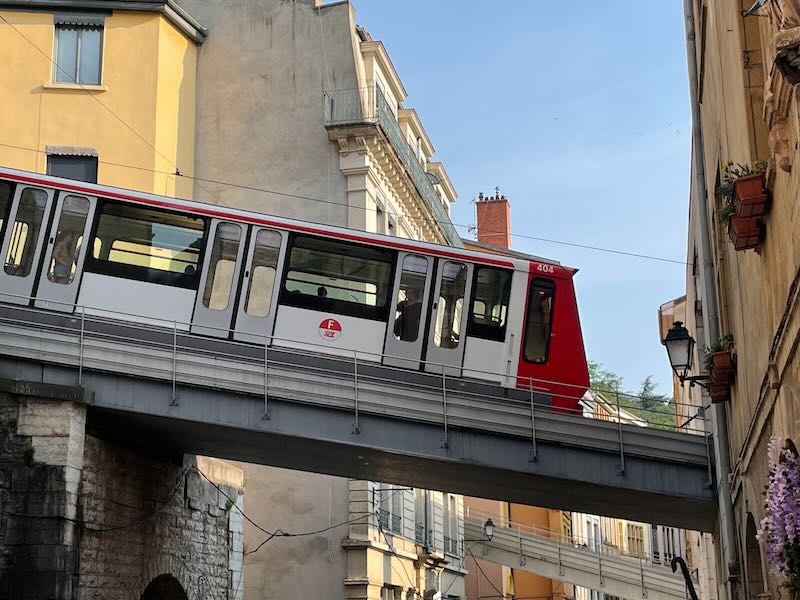 The funicular that takes you up and down to Fourvière Basilica and the roman ruins of Lugdunum
The funicular that takes you up and down to Fourvière Basilica and the roman ruins of Lugdunum31. Embark on a fascinating Lyon walking tour
I may have said it before, but Lyon is a city for walking. Wandering around on your own is a delight, but if your time is limited or you’re afraid you might miss something, take one of the city’s excellent walking tours.
32. See Lyon on two wheels
While walking is one way to see the city, you may prefer something that moves slight more quickly!
How about cycling?
This grand tour lasts three hours and will take you all through the city.
But if you’re feeling slightly less energetic, a guided tour on an electric bike should do the trick. You’ll still have to work at it, but a lot less!
33. Hop on and hop off
You’re undoubtedly familiar with the hop-on hop-off buses in many cities, and they’re popular for a reason.
By taking you around to the major sights, they allow you to get your bearings and to choose what to see and in which order.
Like other world-class cities, Lyon too has its hop-on hop-off buses.
➽ Don't forget to get your Lyon City Card for all public transportation and entrance to museums in Lyon!
Getting to Lyon
Lyon lies at the heart of the region of Auvergne-Rhône-Alpes, one of France's largest regions (there are 18 in all). In these days of high-speed trains, Lyon can be under two hours from Paris, accessible on a day trip depending on which train you choose. The city does, however, deserve a lot more than a day.
And so do its environs! If you spend a few days in Lyon, make sure you take a day trip or two to some of the nearby cities or countryside.
Getting around Lyon
Getting around Lyon is a breeze (as long as you're not driving!)
The city has an extensive and well-organized public transport system, the TCL, or Transports Communs Lyonnais. Here's their route finder, which I use often. I suggest you download the TCL app, available for both IOS and Android phones.
You can buy transport tickets from the ticket machines located at major stops and in the metro, perfect if you don't plan to visit any museums. Here are the different ticket options.
But if you plan to see the sights, consider getting a Lyon City Card, which includes transport along with many of the city's museums.
Cycling in Lyon is also an option and you can rent a bike from Velo'v. Yes, there are cars on the streets, but you can avoid a lot of them by using the smaller streets which, in Lyon, are thankfully plentiful.
HOW TO YOU PRONOUNCE LYON? AND SPELL IT?
Pronouncing this city can be tricky: it's lee-ON, although you pronounce the O but stop just short of the N.
Spelling it also uncovers a range of different interpretations.
- It's often seen as Lyons France – English speakers often add an "s" to the end (the same with Marseilles, which doesn't have an "s" in French). Lyons is not incorrect – but that's not how it's spelled in France.
- Other spellings also occasionally surface: Leon France, or Leone France.
Now you know: L-Y-O-N. Hope this helped!
Where to stay in Lyon
The map below shows you all the accommodation available in Lyon, for any budget.
Ready for your Lyon trip?
Here are some suggestions to make your visit even more enjoyable!
TOP LYON CITY TOURS
➽ Vieux Lyon 4-hour Food Tasting Tour - for inveterate foodies and gastronomes
➽ Discover Lyon Walking Tour - to explore the essence of the city
LYON DAY TRIPS
➽ Golden Stones Beaujolais - heart of the Golden Stone villages for wine lovers
➽ Northern Côtes du Rhône - meeting the winemakers
➽ Beaujolais and Pérouges - wine tasting and a medieval village visit
WHERE TO STAY IN LYON
➽ Villa Florentine - stunning 5-star luxury overlooking the entire city
➽ Mi-Hotel Tour Rose - perfect apartments in historic Vieux Lyon
➽ Fourvière Hotel - elegant simplicity in a former cloister
➽ Hotel du Théatre - budget option in the heart of the classical district
Renting a car in Lyon? Compare prices here.
Traveling here by train? Book your ticket here.
To see the city, don't forget to book your Lyon City Card.
When is the best time to visit Lyon France?
This might surprise you but summer is NOT the best season to visit − it can be hot and stormy although on the other hand, hotel prices are lower. Winter can be cold and snowy BUT − Lyon in December is fun! That's when we have the fabulous Fête des Lumières, the brilliant lights festival during which buildings are clothed in light shows.
Otherwise, these are the best seasons to visit Lyon:
- spring, with April and May usually delightful
- autumn, with a pleasant October and possibly November, not too hot or cold, and not too much rain (but yes, unpredictable)
That said, I've visited Lyon in every season and it's a fabulous city, so even in the "not best" seasons, it is absolutely worth the visit.
Whether you’re planning a weekend or a longer trip, these things to do in Lyon France are the perfect introduction to the city’s food, culture, and history.
FAQ
What are the most popular attractions in Lyon?
What are the most popular attractions in Lyon?
The most-visited attractions are the Basilica of Fourvière, the Old Town (Vieux Lyon), the Musée des Confluences, and the Parc de la Tête d’Or — each showing a different era of Lyon’s long history.
How many days do you need in Lyon?
How many days do you need in Lyon?
Two full days lets you see the highlights — Old Lyon, Fourvière Hill and Les Halles — but plan three days in Lyon if you want to explore museums and nearby Beaujolais.
Is Lyon walkable?
Is Lyon walkable?
Yes, Lyon is very walkable, especially the Presqu’île and Vieux Lyon. Hills like Fourvière can be steep, but you can take the funicular instead of climbing.
Is Lyon cheaper than Paris?
Is Lyon cheaper than Paris?
Generally yes: hotels, restaurants and attractions in Lyon cost 20–30% less than in Paris, making it one of France’s best-value major cities.
What to do in Lyon France on a rainy day?
What to do in Lyon France on a rainy day?
Visit one of the city's fabulous museums, like the Confluence or one of the specialty museums, for example the Gallo-Roman Museum.
What are the best things to do in Lyon France on a Sunday?
What are the best things to do in Lyon France on a Sunday?
Visit the Fourvière Basilica, explore the tiny alleys of the Old Town or visit the Parc de la Tête d'Or.
What are some things to do in Lyon in winter?
What are some things to do in Lyon in winter?
There are plenty of things that are free in Lyon. The traboules and murals, of course, and the riversides (especially on market days). The Parc de la Tête d'Or and its gardens and zoo, and the ruins of old Lugdunum. The Fourvière Basilica is free, but you'll have to pay a few euros to take the funicular (or be brave and walk up).
Before you go...
Lyon doesn’t try to impress — it simply delivers. From its bouchons and Roman ruins to its murals and riverbanks, the city rewards anyone willing to look a little closer. Whether you visit for a weekend or stay longer, you’ll find layers of history, food, and culture that few French cities can match.
If you’re planning your trip, you might also like my Croix-Rousse itinerary: in the footsteps of Lyon’s silk heritage or my list of day trips from Lyon.
And if you enjoy this kind of city guide, take a look at things to do in Avignon, another southern city worth exploring.
Did you enjoy this article? I'd love if you shared it!
 |
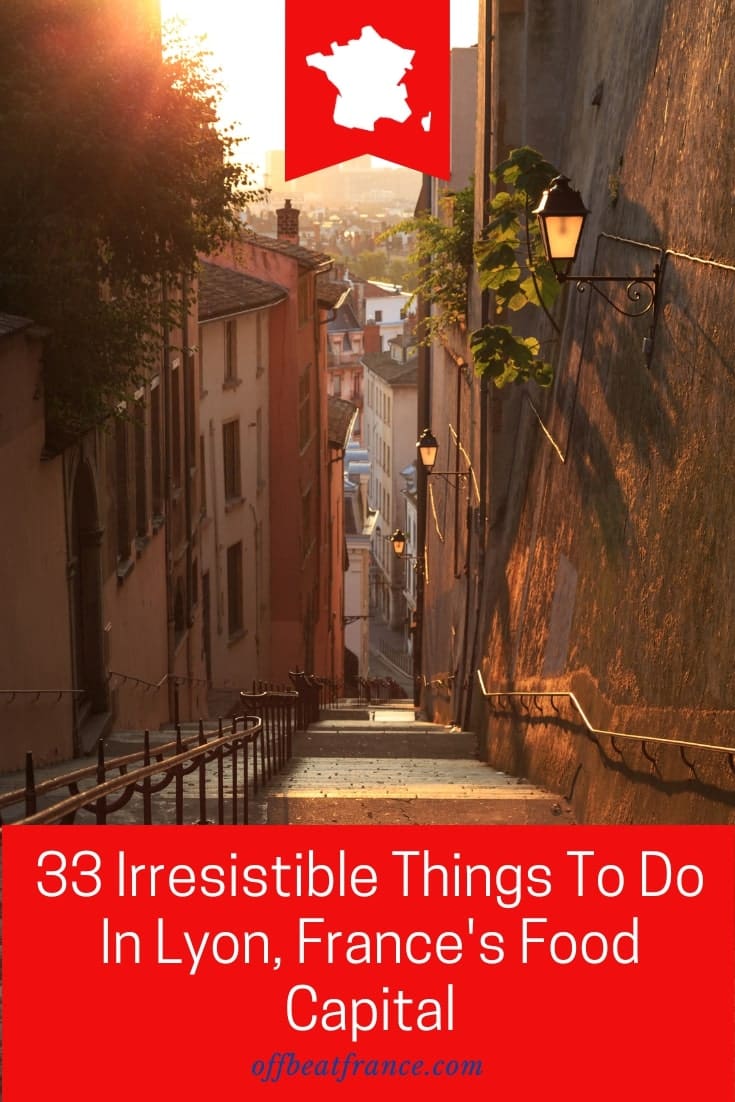 |
